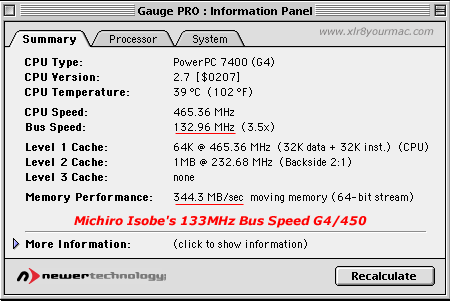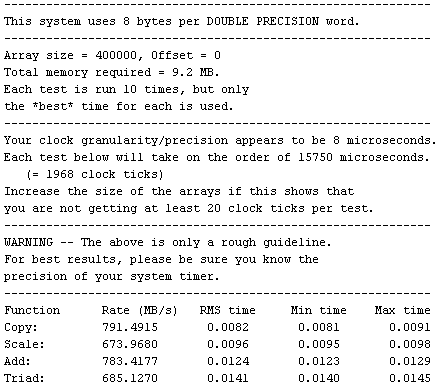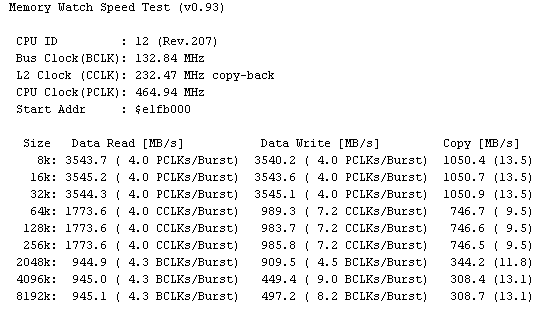 The Source for Mac Performance News and Reviews Apple G4 Sawtooth CPU Module Speed Settings | |
| |
Dual G4/500 CPU Module Speed Settings: Thanks to "Zack" for the photos of a Dual G4/500 module at this page which shows the Bus/CPU ratio resistor areas. (added 12/14/2000) 6/22/2000 Update: 133MHz Bus Speed Notes: Michiro Isobe wrote that he'd found a way to run the G4 at 133MHz bus speeds. The following is from his MaC CPU Upgrade report:
"Power Mac G4/450 rev.A Michiro also sent Stream, Memory Watch and GaugePro test results.
 (Note: My G4/500 (100Mhz bus) reports 234 MB/sec (max) w/GaugePro 1.02/OS 9.04)


133MHz Bus Mod Timebase/Firmware Info:
Best Regards, Michiro Isobe" (Original info added 1/27/2001) Michiro Isobe wrote:
1. G4 (Gigabit Ethernet) and G4 Cube have no time-base problem.
Background:
How to edit and store the NVRAMRC for 133MHz bus
(1) Boot by holding down "Cmd" + "Opt" + "O" + "F" keys to enter the OpenFirmware terminal.
If you fail to edit the NVRAMRC or need to return to the 100MHz bus, you can clear the changes by resetting the nvram, booting by holding down "Cmd" + "Opt" + "P" + "R". (This Apple article also explains how to reset the NVRAM.)
In many cases, 133MHz bus does not work. If it seems to work, it is stable with very limited conditions. (NOTE: Michiro later noted that at 133MHz, only 2 dimm slots were usable (even with 133mhz RAM.) Also see below for comments on problems in OS X with overclocked bus speeds. [Solved by OS X 10.1.2 update he later said.] Remember that 133MHz bus speeds require PC133 RAM *and* a mod to the CPU module to lower the bus/cpu ratio - otherwise the CPU will be so overclocked it will not boot. (I.E. - a G4/450 module is set to 4.5x ratio for the original 100MHz bus - at 133MHz the CPU will be trying to run 600MHz, which will not even boot. And for 450 and 500Mhz G4s - there is no setting that for those CPU speeds exactly, and the closest settings run 466MHz and 533MHz, which may not be reliable since it's overclocking the CPU beyond its rated speeds.) OS X Issues with 133MHz Bus Speed Mod: (added 4/20/2001) "[updated] Mac OS 9.1 resolves the timebase problem of all sawtooth models without Open Firmware tweaking. The only problem is Apple System Profiler still recognizes the bus clock to be 100MHz and displays incorrect machine speed.
of the Apple Sawtooth G4 System:
PLL_CFG signals are set by registers on the back side of the CPU daughter card.
The PLL_CFG code is shown at Table 14 in the following PDF document.
VID signals are set by registers on the back side of the CPU daughter card.
The VID code is the same with Yosemite based system. Please consult the
voltage identification table of this PDF document
http://www.cherrysemiconductor.com/product/PDF/CS-5165PDF.pdf
(3) L2 Signal Level: L2 signal level was specified to be 2.5V by the PPC7400 design docs. But it can be adjusted a little by changing a register at the back side of the CPU daughter card. (See Fig1.jpg and Fig4.jpg for photos identifying these)
Default: R51 = 124 ohm, R52 = 124 ohm.
Bus and AGP/PCI clock can be changed by the registers at the back side of the motherboard. (See Fig5.jpg and Fig6.jpg for photos identifying these) But, I found that the bus overclocing also make the time base run fast. So this modification is nonsense. If you try the bus overclocking, you must find the source of time base and supply a clock independently.
There is frequency table in this PDF document. sg500.pdf [link revised 1/20/2001]
| |
= Other Site Topic Areas =
| |
© 1999, all rights reserved. |